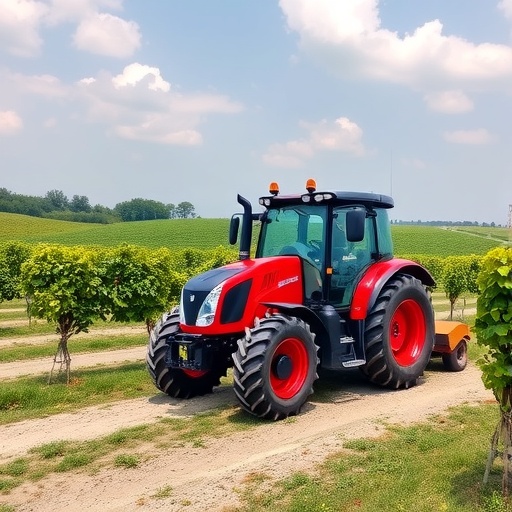In the heart of Italy’s renowned viticultural landscape, a groundbreaking shift is underway that promises to redefine the future of vineyard management. The Politecnico di Milano, a beacon of technological innovation, has embarked on a path that marries mechanical engineering with advanced information technology and sophisticated digital simulation. This pioneering research initiative aims to revolutionize how vineyards operate, ushering in an era of autonomous, high-precision agricultural machinery that not only enhances efficiency but also propels sustainability to the forefront of agricultural practice.
At the core of this innovation lies the development of an intricate digital environment designed to simulate and optimize the operation of self-driving tractors within vineyard settings. This virtual ecosystem, often referred to as a “digital twin,” meticulously mirrors the vineyard’s physical characteristics—including slope gradients, soil texture variations, and the precise geometry of row spacing. By creating this highly realistic simulation, researchers can rigorously test autonomous navigation algorithms, refine control strategies, and predict operational outcomes without the inherent risks and costs of real-world trials.
The research team, comprising experts from the Departments of Mechanical Engineering and Electronics, Information and Bioengineering, has engineered a comprehensive methodological framework for scenario generation. This framework encompasses the synthesis of detailed terrain models and the integration of sensor data streams typical of actual agricultural machinery. By employing low-cost Global Navigation Satellite Systems (GNSS) alongside Inertial Measurement Units (IMU), the virtual tractors execute precise movements that replicate true field conditions. These autonomous vehicles demonstrate an ability to navigate between tightly spaced vine rows and perform complex off-field maneuvers with unprecedented accuracy.
Key to this advancement is the synergistic combination of terrain modeling, sensor emulation, and advanced control algorithms, all embedded within a singular simulation environment. This integration ensures that every aspect influencing vineyard operations—from micro-topography to sensor noise—is faithfully represented. Such fidelity accelerates the iterative process of developing autonomous control systems, bridging the gap between theoretical algorithmic strategies and practical field applications. Furthermore, it dramatically curtails the time and resources traditionally allocated to on-site validation, presenting a transformative leap forward for agricultural engineering.
The implications of this digital twin extend beyond mere operational efficiencies. Researchers envision these simulations as vital tools for operator training, facilitating a controlled setting where human supervisors can familiarize themselves with autonomous machinery behaviors and refine intervention protocols without risking crop damage or machinery faults. This educational facet is seen as a crucial catalyst for broader adoption of automation technologies, breaking down barriers related to unfamiliarity and mistrust that commonly hinder innovation in traditional farming communities.
The initiative has been bolstered through a collaborative partnership with Soluzioni Ingegneria s.r.l., an industry leader specializing in dynamic vehicle simulation software. This alliance embeds academic innovation within the practical frameworks demanded by commercial agricultural equipment manufacturers, ensuring that theoretical models translate effectively into market-ready technologies. It is this blend of scholarly research and industrial application that positions the project at the nexus of agricultural automation and sustainable farming.
From a sustainability perspective, the precise control afforded by autonomous tractors promises substantial environmental benefits. More exact navigation reduces soil compaction and disturbance, while the ability to execute carefully modulated maneuvers minimizes resource wastage. Additionally, optimizing field operations through predictive algorithms aligns with broader ecological goals to reduce carbon footprints and conserve soil health, thereby contributing to resilient agricultural ecosystems in the face of climate change.
This research arrives at a pivotal moment for global agriculture, where the dual pressures of increasing food demand and environmental stewardship mandate innovative technological responses. By embedding advanced robotics and sensor technologies within the unique context of vineyards, the Politecnico di Milano project addresses a sector ripe for disruption. Traditional viticulture, often labor-intensive and tailored to delicate crop requirements, is now poised to embrace automation without compromising the intricate balance of terroir and grape quality.
The published findings, detailed in the latest issue of AgriEngineering, offer a comprehensive analysis of the methodologies employed, simulation parameters, and algorithmic control strategies. The paper elucidates the challenges inherent in replicating complex vineyard environments digitally and discusses the iterative optimization process through which autonomous tractor performance was enhanced. This transparency not only advances academic discourse but also provides a valuable reference point for developers and practitioners aiming to implement similar systems across diverse agricultural contexts.
Beyond the immediate scope of viticulture, the technological principles underpinning this research hold broader applicability. The combination of digital twins with sensor-driven autonomous machinery paves the way for smarter, more resilient farming operations across various crops and terrains. By validating control strategies in virtual environments, stakeholders can anticipate system behaviors under myriad conditions, thereby reducing uncertainty and enhancing decision-making efficacy.
The vision articulated by Professor Federico Cheli, who leads the Mechanical Engineering department and coordinates the project, encapsulates a future where digital simulation is integral to agricultural innovation. His emphasis on integrating realistic sensors, terrain data, and advanced controls reflects a holistic approach that acknowledges the multifaceted challenges of field automation. This mindset exemplifies the evolving role of engineering disciplines in shaping next-generation food systems.
As autonomous technologies gain foothold in agriculture, the nexus of simulation science, robotics, and environmental sustainability will undoubtedly expand. The achievements of the Politecnico di Milano team demonstrate the feasibility and value of a simulation-first approach to developing high-precision vineyard operations. Their work embodies a critical step toward smart agriculture, where data-driven insights and autonomous control converge to cultivate not only grapes but a more sustainable and productive future for farming worldwide.
Subject of Research: Not applicable
Article Title: Scenario Generation and Autonomous Control for High-Precision Vineyard Operations
News Publication Date: 11th November 2025
Web References: http://dx.doi.org/10.3390/agriengineering7020046
References: Ruiz Mayo, C.; Cheli, F.; Arrigoni, S.; Paparazzo, F.; Mentasti, S.; Pezzola, M.E. Scenario Generation and Autonomous Control for High-Precision Vineyard Operations. AgriEngineering 2025, 7(2), 46.
Image Credits: Politecnico di Milano
Keywords: Agricultural engineering, Sustainable agriculture, Robots
Tags: agricultural engineering researchalgorithm testing in vineyardsautonomous agricultural machinerydigital environment for tractorsdigital twin simulationmechanical engineering in agriculturePolitecnico di Milanoprecision farming technologyself-driving tractor innovationsustainable agricultural practicesvineyard management advancementsvirtual vineyards technology





